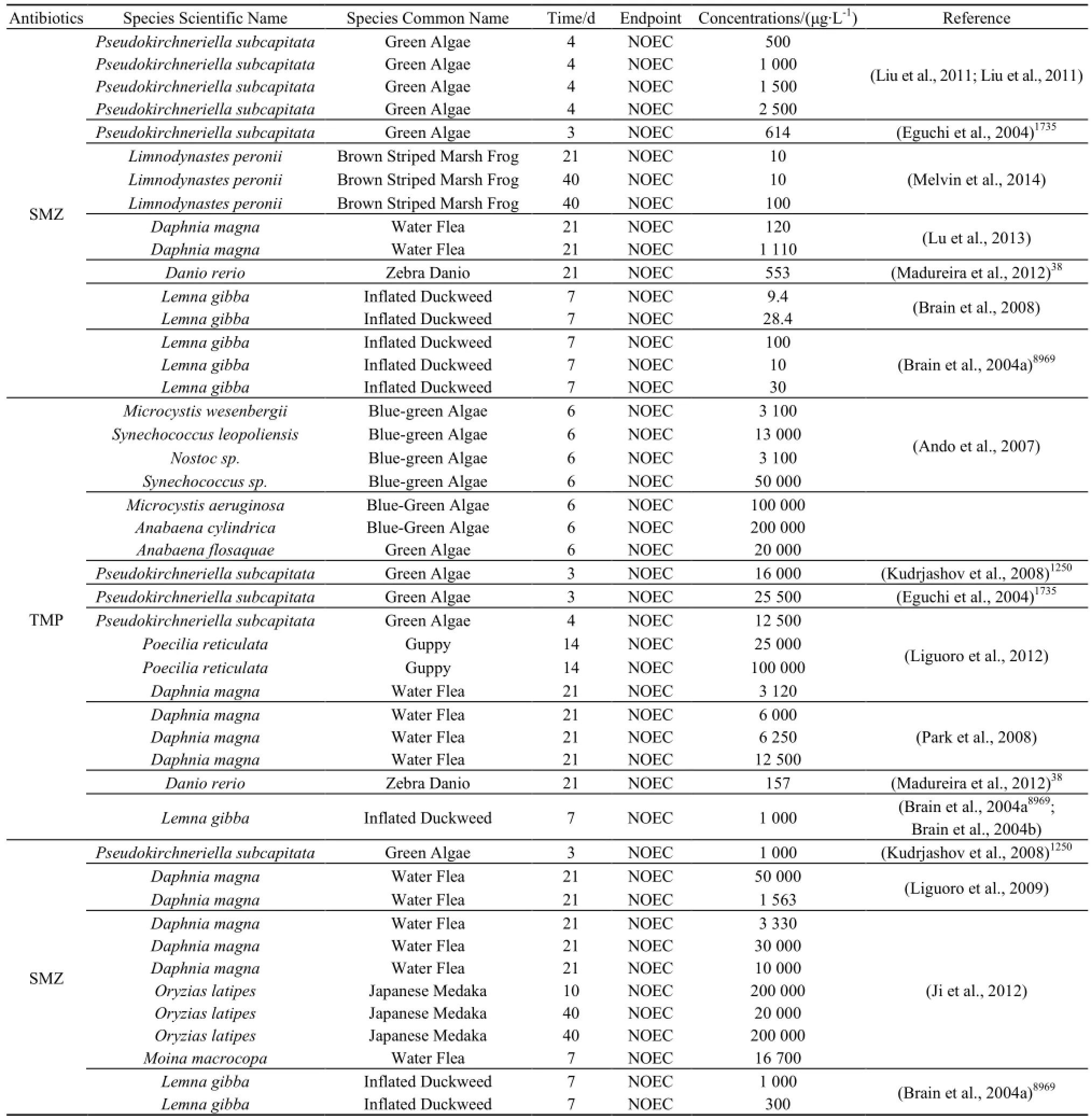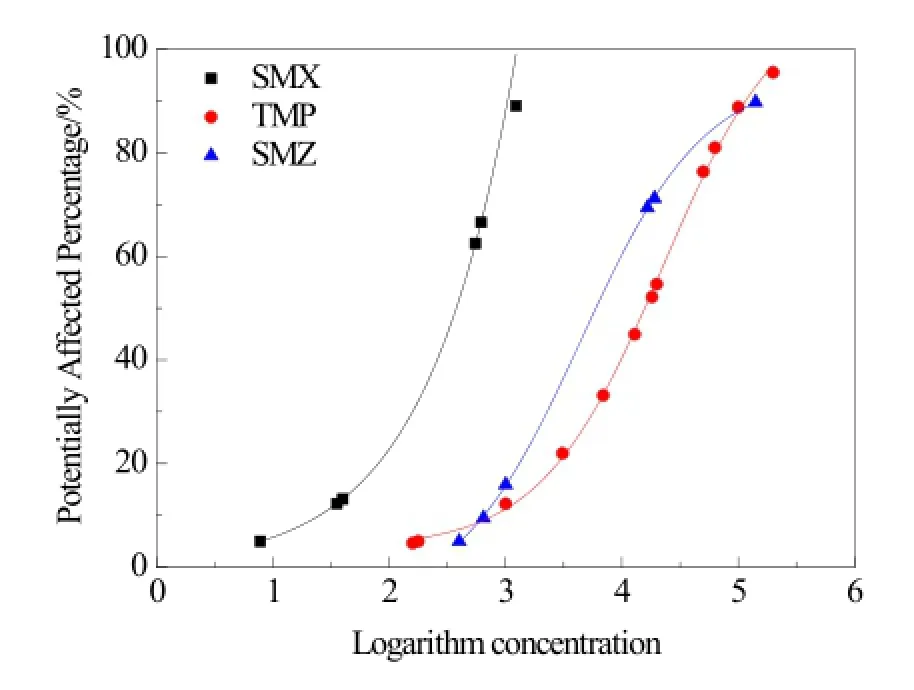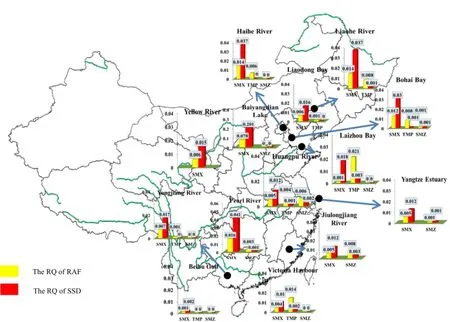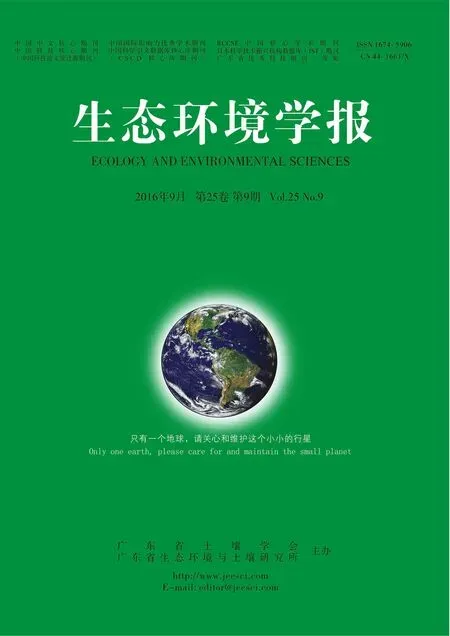地表水中磺胺类抗生素的生态风险评价
汪涛,杨再福,陈勇航,张姚姚,孙冉冉,薛滢,张梦婷
东华大学环境科学与工程学院,上海 201620
地表水中磺胺类抗生素的生态风险评价
汪涛,杨再福*,陈勇航,张姚姚,孙冉冉,薛滢,张梦婷
东华大学环境科学与工程学院,上海 201620
抗生素滥用导致地表水中频繁检出抗生素抗性基因,抗生素抗性基因对生态环境和人体健康具有潜在危害。收集整理磺胺甲恶唑(SMX)、甲氧苄氨嘧啶(TMP)、磺胺二甲嘧啶(SMZ)3种磺胺类抗生素的慢性毒性参数数据(NOEC)及其在中国14个不同地表水中的环境检测浓度(MEC),得到SMX、TMP、SMZ的NOEC值范围分别为9.4~2500、157~200000、300~200000 μg∙L-1,其对藻类、甲壳类、鱼类3个营养级中最敏感的物种分别为大型蚤Daphnia magna、斑马鱼Danio rerio、月牙藻Pseudokirchneriella subcapitata,三者的NOEC值分别为120、157、1000 μg∙L-1;地表水中SMX、TMP、SMZ最大MEC分别出现于白洋淀湖(940 ng∙L-1)、莱州湾(330 ng∙L-1)、九龙江(775.5 ng∙L-1)。采用风险评价因子(RAF)和物种敏感性分布(SSD)分别计算出3种磺胺类抗生素的预测无效应浓度(PNEC),RAF法得到的PNEC值分别为12、15.7、100 μg∙L-1,SSD法得到的PNEC分别为4.674、107.394、255.516 μg∙L-1。通过风险熵(RQ)法对不同地表水中3种磺胺类抗生素进行生态风险评价,结果显示除了白洋淀湖中SMX的RQ值为0.201,存在潜在风险,其他水域中RQ均小于0.1,说明中国地表水中SMX、TMP、SMZ风险很小或无风险。
磺胺类抗生素;预测无效应浓度;风险评价因子;物种敏感性分布;生态风险评价
磺胺类抗生素(Sulfonamides,SAs)在 1932年被德国的杜马克首次应用,它是一种具有广谱抗革兰氏阳性和革兰氏阴性菌活性且价格低廉的人兽共用药,被广泛用于临床、畜牧养殖和水产养殖(王娜,2014)。我国从20世纪40年代开始生产磺胺类药物,到2003年产量已突破20000 t(何金华等,2012)。Kim et al.(2008)研究表明磺胺类抗生素的排泄率为 67%~90%,被排出的磺胺类抗生素大量进入地表水。冀秀玲等(2011)检测的上海市某养殖污水及附近农田灌溉渠河水中3种磺胺类总量为197.7~323.0 ng∙L-1,磺胺类耐性基因中以sulA含量最高,绝对拷贝数为108.4108~1010.3728。抗生素的残留会导致病原微生物产生耐药性,使得抗生素杀死细菌的有效剂量不断增加。低剂量的抗生素长期排入环境中,对环境微生物具有选择压力,诱导产生抗性基因且抗性基因可以在环境中扩展和演化,对生态环境及人类健康造成潜在威胁。除了能引起细菌的耐药性,抗生素对其它生物也可能产生一定的毒性,影响环境微生物活性和群落结构(Karthikeyan et al.,2006)。Byrnebailey et al.(2009)在英国施用猪粪的农田中分离了531个菌株,所有菌株均检测到sul1、sul2、sul3 3种磺胺类抗性基因。Kong et al.(2006)研究发现土霉素浓度升高将显著降低土壤微生物群落功能结构。磺胺甲恶唑(Sulfamethoxazole,SMX)、甲氧苄氨嘧啶( Trimethoprim,TMP) 及磺胺 二甲 嘧啶(Sulfamethazine,SMZ)作为3种最常用磺胺类抗生素而广泛存在于水环境中,和其他抗生素一样对环境微生物具有选择压力并诱导抗性基因产生的作用。其中,SMX是由美国食品及药物管理局规定的需要优先被检测的14种磺胺类药物中的一种(银仁莉,2014)。SMX的使用量大,在我国水环境中检出报道次数最多,2014年已达到15次,且检出率均大于60%(王丹等,2014)。近年来地表水磺胺类抗生素的含量检测报道较多,但采用风险评价因子(risk assessment factor,RAF)和物种敏感性分布(species sensitivity distribution,SSD)两种方法对中国地表水进行定量风险评价的报道较少。本文选取SMX、TMP、SMZ 3种磺胺类抗生素为研究对象,采用风险评价因子法(RAF)和物种敏感性分布(SSD)法计算3种磺胺类抗生素的预测无效应浓度(predicted no effect concentration,PNEC),最后通过风险熵(risk quotient,RQ)进行生态风险定量评价,以期为磺胺类抗生素的污染控制与合理使用提供科学的参考依据。
1 材料与方法
1.1 数据收集与筛选
本研究中SMX、TMP、SMZ的生态毒性数据来源于已发表文献和 EPA ECOTOX毒性数据库(USA EPA,2016)。欧盟技术指导文件(technical guidance document,TGD)推荐使用慢性毒性参数——无可见效应浓度(no observed effect concentration,NOEC)计算PNEC值(EMEA,2006)。数据筛选要求有明确的受试生物、测试终点、暴露时间及相关文献出处,不采用信息不全的数据。慢性毒性测试影响终点为生长、死亡等,慢性毒性实验时间要求藻类、无脊椎动物、脊椎动物分别大于或等于3、7、14 d,当没有可用的NOEC数据时,采用10%最大效应浓度(concentration for 10% of maximal effect,EC10)或 50%最低可见效应浓度(lowest observed effect concentration,LOEC)作为NOEC(Lei et al.,2015)。相同物种不同测试终点时,选择最敏感数据作为NOEC;同一物种同一个测试终点存在多个毒性数据时,采用算数平均值计算(European Commission,2003)147。关于地表水中 3种磺胺类抗生素的环境检测浓度(measured environmental concentration,MEC)数据均来源于已发表文献。选用具有代表性的河流、湖泊等地表水域,整理各地表水中3种磺胺类抗生素的浓度范围,将最大检测浓度作为MEC值。
1.2 SMX、TMP、SMZ的PNEC推导方法
1.2.1 风险评价因子法
风险评价因子法属于确定性评价,通过某个确定的风险评估因子来外推获得PNEC,适用于毒性数据较少的化合物。本文采用慢性毒性参数NOEC计算PNEC值,根据TGD推荐标准计算方法:PNEC等于最低毒性指标除以风险评价因子,即:

风险评价因子选择是根据可用的生态毒性数据情况(见表1)进行的。当3个营养级中至少存在一个可用短期半数致死浓度(LC50)或半数效应浓度(EC50)值时,则选择1000作为风险评价因子;当3个营养级中存在一个NOEC值时,选择100作为风险评价因子;当3个营养级中有两个可用NOEC值时,用50作为风险评价因子;若每个营养级都有NOEC值,则选用10作为风险评价因子(European Commission,2003)100-101。
1.2.2 物种敏感性分布法
物种敏感度分布曲线法(SSD)是生态风险评价中一种常用的外推方法。一般用作最大环境许可浓度阈值(HCx,通常取值 HC5),HC5表示该浓度下受到影响物种数不超过总物种数的 5%,即达到95%物种保护时的浓度(Wheeler et al.,2002)。从HC5出发可得到用于生态风险评价的环境质量标准中的预测无效应浓度PNEC值。SSD要求获得4种以上不同类别生物的毒性数据(梁峰,2011)。SSD的构建可以使用急性数据或慢性数据,本文使用慢性参数数据 NOEC值来构建 SSD。从 EPA ECOTOX收集到的数据利用分布函数模型(Burr-Ⅲ型分布统计软件)进行物种敏感性分布(SSD)曲线拟合,该软件由澳大利亚联邦科学和工业研究组织提供,Burr-Ⅲ型函数的参数方程(孙聪等,2014)为:

式中,x为水环境中SMX、TMP、SMZ质量浓度(mg∙L-1),b、c、k为函数的3个参数。PNEC值的计算是通过HC5或者NOEC分布的第5个百分位值除以一个额外的评价因子,即:

式中,AF取1到5,反映数据的不确定性。虽然有相关信息用于选择评价因子,但选择结果具有不确定性且存在硬性标准,因此PNEC值是一个范围值,称为概率性PNEC。本文选其几何平均值作为最终PNEC值(European Commission,2003102;Straub,2013)。
1.2.3 SMX、TMP、SMZ的生态风险特征
根据传统的生态风险评价方法,单一化合物风险熵的计算方法为环境检测浓度MEC或环境预测浓度(PEC)与预测无效应浓度(PNEC)的比值(RQ=PEC/PNEC或RQ=MEC/PNEC)(Cooper et al.,2008)。由于缺少中国地表水中磺胺类抗生素的详细使用与排放数据,所以本文使用MEC值来计算风险熵。当RQ<0.1时被认为存在风险或不利影响;当0.1<RQ<1时,则存在低风险或潜在的不利影响;当 1<RQ<10时,则认为存在中等风险或不利影响;而 RQ>10时,则表明该物质具有高风险,应该被重点关注(Mendoza et al.,2015)。

表1 SMX、TMP、SMZ的慢性毒性数据Table 1 The Chronic toxicity data of SMX、TMP、SMZ
2 结果与讨论
2.1 数据收集与筛选
对EPA ECOTOX的数据进行筛选后,分别得到符合条件的SMX、TMP、SMZ慢性毒性参数数据(见表2)。SMX的NOEC值范围为9.4~2500 μg∙L-1, 包 含 月 牙 藻 ( Pseudokirchneriella subcapitata)、裴氏汀蟾属(Limnodynastes peronii)、大型蚤(Daphnia magna)、斑马鱼(Danio rerio)以及浮萍(Lemna gibba)5个物种,其中藻类、甲壳类、鱼类3个营养级中最敏感的物种为甲壳类中的大型蚤,其NOEC值为120 μg∙L-1;TMP的NOEC值范围为 157~200000 μg∙L-1,包含惠氏微囊藻(Microcystis wesenbergii)、聚球藻(Synechococcus leopoliensis)、念球藻属(Nostoc sp.)、聚球藻属(Synechococcus sp.)、水华鱼腥藻(Anabaena cylindrica)、铜绿微囊藻(Microcystis aeruginosa)、月牙藻(Pseudokirchneriella subcapitata)、鱼腥蓝细菌(Anabaena flosaquae)、大型蚤(Daphnia magna)、孔雀鱼(Poecilia reticulata)、斑马鱼(Danio rerio)、浮萍(Lemna gibba)等12个物种,其中藻类、甲壳类、鱼类3个营养级中最敏感的物种为斑马鱼,其NOEC值为157 μg∙L-1;SMZ的NOEC值范围为 300~200000 μg∙L-1,包含月牙藻(Pseudokirchneriella subcapitata)、大型蚤(Daphnia magna)、多刺裸腹蚤(Moina macrocopa)、浮萍(Lemna gibba)、青鳉(Oryzias latipes)等5个物种,其中藻类、甲壳类、鱼类3个营养级中最敏感的物种为月牙藻,其NOEC值为1000 μg∙L-1。

表2 地表水中SMX、TMP、SMZ的浓度范围与MEC值Table 2 The concentration and MEC of SMX, TMP, SMZ in surface waters ng∙L-1
本研究收集整理了包括辽河和辽东湾、渤海湾、海河、莱州湾、白洋淀湖、黄河、长江口、黄浦江、九龙江、邕江、珠江、维多利亚港以及北部湾等中国14个不同地表水中共331个SMX、TMP、SMZ的浓度测定值(见表 2),并将最大浓度值作为MEC值用于计算SMX、TMP、SMZ的风险熵。在所有水域中,白洋淀湖的SMX最大,为940 ng∙L-1;TMP的最大值出现在莱州湾,为330 ng∙L-1;SMZ的最大值出现在九龙江,为775.5 ng∙L-1。
2.2 SMX、TMP、SMZ的PNEC值
根据已有的数据,分别运用RAF法和SSD法计算SMX、TMP、SMZ的PNEC值。通过RAF法计算SMX、TMP、SMZ的PNEC值分别为12、15.7、100 μg∙L-1(见表3)。
在SSD法中,根据已有的数据应用Burr-Ⅲ型分布统计软件得到SMX、TMP、SMZ的物种敏感分布曲线(见图1),从而得出3种磺胺类抗生素基于基于95%概率敏感生物的HC5值分别为7.79、178.99、425.86 μg∙L-1。最终计算得到的PNEC范围分别为1.558~7.79、35.798~178.99、85.172~425.86 μg∙L-1,平均值分别为4.674、107.394、255.516 μg∙L-1(见表4)。

表3 RAF法计算SMX、TMP、SMZ的PNEC结果Table 3 The results of PNEC of SMX、TMP and SMZ were calculated by RAF μg∙L-1

图1 SMX、TMP、SMZ物种敏感分布Fig. 1 Species sensitivity distribution of chronic toxicity data for SMX, TMP, SMZ

表4 SSD法计算HC5与PNEC的结果Table 4 The results of PNEC and HC5were calculated by SSD
2.3 地表水中SMX、TMP、SMZ的生态风险评价

图2 中国地表水中SMX、TMP、SMZ的风险商值Fig. 2 The risk quotient values of SMX, TMP, SMZ based on both ERA and SSD in surface water of China
本研究通过风险熵的方法对中国 14个不同地表水域中SMX、TMP、SMZ的生态风险进行评价(见图2)。结果显示辽河、渤海、河海、白洋淀湖、珠江中SMX的RQ值相对较高,最大值是白洋淀湖的0.201;TMP在莱州湾和维多利亚港中RQ值相对较高,分别为0.021、0.014;SMZ的RQ值均普遍较低。3种磺胺类抗生素中SMX的RQ值依次高于TMP和SMZ,说明地表水中SMX的风险相对较高,而SMZ的风险最小。总体而言,除了白洋淀湖中SMX的RQ值为0.201(大于0.1),存在潜在风险,其他水域中SMX、TMP、SMZ的RQ均小于0.1,说明中国地表水中3种磺胺类抗生素风险很小或无风险。
2.4 讨论
本文通过风险熵法对地表水3种磺胺类抗生素进行生态风险评价。关于中国地表水磺胺类抗生素风险评价的研究已有报道,薛保铭等(2013)对钦州湾水体中4种磺胺类抗生素和甲氧苄氨嘧啶进行生态风险评价,结果表明磺胺甲恶唑对相应的敏感物种的风险熵值大于 0.1,为中等风险。姜蕾等(2014)对黄浦江上游水体中 6种磺胺类抗生素分布特征与生态风险进行了研究,初步评价结果显示,6种磺胺类抗生素均不存在生态风险。严清等(2013)研究了重庆主要城区水域中磺胺类抗生素污染水平和生态风险,结果显示除磺胺甲恶唑的风险熵值大于 0.1,为中等风险,其他均无风险。杜雪(2015)对南昌市地表水体中3种磺胺类抗生素的污染特征与生态风险评价进行了研究,结果表明磺胺类抗生素在水产养殖区、城市生活区、畜禽养殖区及高校群区的生态风险分别为高风险、中等风险、中等风险和无风险。秦延文等(2015)对大辽河表层水体典型抗生素污染特征与生态风险评价进行了研究,结果显示磺胺甲恶唑风险较高。
本研究分别采用 RAF法和 SSD法计算得到PNEC值,RAF法简单可行,适用于数据较少的情况;SSD法则充分利用毒性数据,具有统计学意义,更有说服力,两种方法相互补充。另外,根据抗生素是非剧毒性物质的特点,采用TGD推荐的慢性数据进行PNEC计算,结果更加准确。虽然我国地表水中磺胺类抗生素风险很小,但由于其频繁进入环境,使得磺胺类抗生素成为“假持久性”物质,磺胺类抗生素对环境细菌具有选择压力,可诱导细菌产生抗性基因甚至产生超级细菌,对人体健康和生态环境产生不利影响。近年来已有 20多个国家发现超级细菌感染,包括欧洲、北美、非洲及亚洲地区,而在我国宁夏、福建、杭州以及台湾等地也均有超级细菌感染的病例报道(王瑶等,2012)。滥用抗生素是产生超级细菌的重要原因,全世界每年有50%的抗生素被滥用,而我国甚至接近80%(新华网,2010)。因此,抗生素的环境污染已成为我国面临的重大环境问题之一,应进一步研究磺胺类抗生素和抗性基因的风险。
3 结论
利用EPA ECOTOX和已发表文献中SMX、TMP、SMZ的慢性毒性数据以及中国14个不同地表水域中SMX、TMP、SMZ的浓度数据等资料得到SMX、TMP、SMZ的NOEC值和MEC值,分别采用RAF和SSD两种方法得到PNEC值,并通过风险熵的方法算出SMX、TMP、SMZ在不同地表水域的RQ值,最后对其进行生态风险评价,得出以下结论:
(1)符合条件的物种中,SMX、TMP、SMZ的NOEC值范围分别为9.4~2500、157~200000、300~200000 μg∙L-1。其中藻类、甲壳类、鱼类3个营养级中对SMX、TMP、SMZ最敏感的物种分别为大型蚤、斑马鱼、月牙藻,NOEC值分别为为120、157、1000 μg∙L-1。地表水中SMX、TMP、SMZ最大MEC分别出现于白洋淀湖(940 ng∙L-1)、莱州湾(330 ng∙L-1)、九龙江(775.5 ng∙L-1)。
(2)通过RAF法计算SMX、TMP、SMZ的PNEC值,分别为12、15.7、100 μg∙L-1。在SSD法中,应用Burr-Ⅲ型分布统计软件得到SMX、TMP、SMZ的HC5值,分别为7.79、178.99、425.86 μg∙L-1。最终计算得到的概率性 PNEC分别为 4.674、107.394、255.516 μg∙L-1。
(3)通过风险熵的方法对中国不同地表水域中SMX、TMP、SMZ的生态风险进行评价。结果显示除了白洋淀湖中SMX的RQ值为0.201(大于0.1),存在潜在风险,其他水域中 SMX、TMP、SMZ的RQ均小于0.1,说明中国地表水中SMX、TMP、SMZ风险很小或无风险。
ANDO T, NAGASE H, EGUCHI K, et al. 2007. A novel method using cyanobacteria for ecotoxicity test of veterinary antimicrobial agents [J]. Environmental Toxicology & Chemistry, 26(4): 601-606.
BRAIN R A, JOHNSON D J, RICHARDS S M, et al. 2004a. Effects of 25 pharmaceutical compounds to Lemna gibba using a seven-day static-renewal test [J]. Environmental Toxicology & Chemistry, 23(2): 371-382.
BRAIN R A, JOHNSON D J, RICHARDS S M, et al. 2004b. Microcosm evaluation of the effects of an eight pharmaceutical mixture to the aquatic macrophytes Lemna gibba, and Myriophyllum sibiricum [J]. Aquatic Toxicology, 70(1): 23-40.
BRAIN R A, RAMIREZ A J, FULTON B A, et al. 2008. Herbicidal effects of sulfamethoxazole in Lemna gibba: using p-aminobenzoic acid as a biomarker of effect [J]. Environmental Science & Technology, 42(23): 8965-8970.
BYRNEBAILEY K G, GAZE W H, KAY P, et al. 2009. Prevalence of sulfonamide resistance genes in bacterial isolates from manured agricultural soils and pig slurry in the United Kingdom [J]. Antimicrobial Agents & Chemotherapy, 53(2): 696-702.
COOPER E R, SIEWICKI T C, PHILLIPS K. 2008. Preliminary risk assessment database and risk ranking of pharmaceuticals in the environment [J]. Science of the Total Environment, 398(1-3): 26-33.
EGUCHI K, NAGASE H, OZAWA M, et al. 2004. Evaluation of antimicrobial agents for veterinary use in the ecotoxicity test using microalgae [J]. Chemosphere, 57(11): 1733-1738.
EMEA. 2006. Guideline on the environmental risk assessment of medicinal products for human use The European Agency for the Evaluation of Medicinal Products: Committee for Medical Products for Human Use [EB/OL]. EMEA/CHMP/SWP/4447/00.
EUROPEAN COMMISSION. 2003. Technical guidance document on risk assessment in support of commission directive 93/67/EEC on risk assessment for new notified substances, commission regulation (EC) No 1488/94 on risk assessment for existing substances, directive 98/8/EC of the european parliament and of the council concerning the placing of biocidal products on the market. European Union: Brussels, Belgium. Available [EB/OL]. online: http://Publications.jrc.ec.europa. eu/repository/handle/JRC23785.
JI K, KIM S, HAN S, et al. 2012. Risk assessment of chlortetracycline, oxytetracycline, sulfamethazine, sulfathiazole, and erythromycin in aquatic environment: are the current environmental concentrations safe? [J]. Ecotoxicology, 21(7): 2031-2050.
JIA A, HU J Y, WU X Q, et al. 2011. Occurrence and source apportionment of sulfonamides and their metabolites in Liaodong Bay and the adjacent Liao River Basin, North China [J]. Environmental Toxicology & Chemistry, 30(6): 1252-1260.
JIANG L, HU X L, YIN D Q, et al. 2011. Occurrence, distribution and seasonal variation of antibiotics in the Huangpu River, Shanghai, China [J]. Chemosphere 82(6): 822-828.
KARTHIKEYAN K G, MEYER M T. 2006. Occurrence of antibiotics in wastewater treatment facilities in Wisconsin, USA [J]. Science of the Total Environment, 361(1-3): 196-207.
KIM Y, JUNG J, KIM M, et al. 2008. Prioritizing veterinary pharmaceuticals for aquatic environment in Korea [J]. Environmental Toxicology & Pharmacology, 26(2): 167-176.
KONG, MARSCHNER. 2006. The veterinary antibiotic oxytetracycline and Cu influence functional diversity of the soil microbial community [J]. Environmental Pollution, 143(1): 129-137.
KUDRJASHOV B A, STRUKOVA S M, SOLODENKO N M, et al. 2008. Growth Inhibiting effects of twelve antibacterial agents and their mixtures on the freshwater microalga pseudokirchneriella subcapitata [J]. Environmental Toxicology & Chemistry, 27(5): 1201-1208.
LEI G, LI Z, PEI G, et al. 2015. Ecological risk assessment of bisphenol A in surface waters of China based on both traditional and reproductive endpoints [J]. Chemosphere, 139: 133-137.
LI W H, SHI Y L, GAO L H, et al. 2012. Occurrence of antibiotics in water, sediments, aquatic plants, and animals from Baiyangdian Lake in North China [J].Chemosphere, 89(11): 1307-1315.
LIGUORO M D, FIORETTO B, POLTRONIERi C, et al. 2009. The toxicity of sulfamethazine to Daphnia magna, and its additivity to other veterinary sulfonamides and trimethoprim [J]. Chemosphere, 75(11): 1519-1524.
LIGUORO M D, LEVA V D, BONA M D, et al. 2012. Sublethal effects of trimethoprim on four freshwater organisms [J]. Ecotoxicology & Environmental Safety, 82(4): 114-121.
LIU B Y, NIE X P, LIU W Q, et al. 2011. Toxic effects of erythromycin, ciprofloxacin and sulfamethoxazole on photosynthetic apparatus in Selenastrum capricornutum [J]. Ecotoxicology & Environmental Safety, 74(4): 1027-1035.
LIU B, LIU W, NIE X, et al. 2011. Growth response and toxic effects of three antibiotics on Selenastrum capricornutum, evaluated by photosynthetic rate and chlorophyll biosynthesis [J]. Journal of Environmental Sciences, 23(9): 1558-1563.
LU G, LI Z, LIU J. 2013. Effects of selected pharmaceuticals on growth, reproduction and feeding of Daphnia Magna [J]. Fresenius Environmental Bulletin, 22(9): 2583-2589.
MADUREIRA T V, ROCHA M J, CRUZEIRO C, et al. 2012. The toxicity potential of pharmaceuticals found in the Douro River estuary (Portugal): Evaluation of impacts on fish liver, by histopathology, stereology, vitellogenin and CYP1A immunohistochemistry, after sub-acute exposures of the zebrafish model [J]. Environmental Toxicology & Pharmacology, 34(1): 34-45.
MELVIN S D, CAMERON M C, LANCTOT C M. 2014. Individual and mixture toxicity of pharmaceuticals naproxen, carbamazepine, and sulfamethoxazole to Australian Striped Marsh Frog Tadpoles(Limnodynastes peronii) [J]. Journal of Toxicology and Environmental Health, Part A, 77(6): 337-345.
MENDOZA A, ACEÑA J, PÉREZ S, et al. 2015. Pharmaceuticals and iodinated contrast media in a hospital wastewater: A case study to analyse their presence and characterise their environmental risk and hazard [J]. Environmental Research, 140(9): 225-241.
MINH T B, LEUNG H W, LOI I H, et al. 2009. Antibiotics in the Hong Kong metropolitan area: Ubiquitous distribution and fate in Victoria Harbour [J]. Marine Pollution Bulletin, 58(7): 1052-1062.
PARK S, CHOI K. 2008. Hazard assessment of commonly used agricultural antibiotics on aquatic ecosystems [J]. Ecotoxicology, 17(6): 526-538.
STRAUB J O. 2013. An environmental risk assessment for Human-use trimethoprim in European surface waters [J]. Antibiotics, 2(1): 115-162.
USA EPA [EB/OL]. 2016.http://www.epa.gov/ecotox/
WHEELER J R, GRIST E P M, LEUNG K M Y, et al. 2002. Species sensitivity distributions: data and model choice [J]. Marine Pollution Bulletin, 45(11): 192-202.
XU W H, GAN Z, ZOU S C, et al. 2009. A preliminary investigation on the occurrence and distribution of antibiotics in the Yellow River and its tributaries, China [J]. Water Environment Research, 81(3): 248-254.
XU W H, ZHANG G, ZOU S C, et al. 2007. Determination of selected antibiotics in the Victoria Harbour and the Pearl River, South China using high-performance liquid chromatography-electrospray ionization tandem mass spectrometry [J]. Environmental Pollution, 145(3): 672-679.
YAN C, YANG Y, ZHOU J, et al. 2013. Antibiotics in the surface water of the Yangtze Estuary: Occurrence, distribution and risk assessment [J]. Environmental Pollution, 175(8): 22-29.
ZHANG D, LIN L, LUO Z, et al. 2011. Occurrence of selected antibiotics in Jiulongjiang River in various seasons, South China [J]. Journal of Environmental Monitoring Jem, 13(7): 1953-1960.
ZHANG R, ZHANG G, ZHENG Q, et al. 2012. Occurrence and risks of antibiotics in the Laizhou Bay, China: impacts of river discharge [J]. Ecotoxicology and Environmental Safety, 80(2): 208-215.
ZHENG Q, ZHANG R, WANG Y, et al. 2012. Occurrence and distribution of antibiotics in the Beibu Gulf, China: Impacts of river discharge and aquaculture activities [J]. Marine Environmental Research, 78(8): 26-33.
ZOU S, XU W, ZHANG R, et al. 2011. Occurrence and distribution of antibiotics in coastal water of The Bohai Bay, China: impacts of river discharge and aquaculture activities [J]. Environmental Pollution, 159(10): 2913-2920.
杜雪. 2015. 南昌市四种典型地表水体抗生素污染特征与生态风险评估[D]. 南昌: 南昌大学: 42-48.
何金华, 丘锦荣, 贺德春, 等. 2012. 磺胺类药物的环境行为及其控制技术研究进展[J]. 广东农业科学, 39(7): 225-229.
冀秀玲, 刘芳, 沈群辉, 等. 2011. 养殖场废水中磺胺类和四环素抗生素及其抗性基因的定量检测[J]. 生态环境学报, 20(5): 927-933.
姜蕾, 蔡海芸, 卢宁. 2014. 黄浦江上游水体中抗生素的分布特征与生态风险[J]. 净水技术, (S2): 81-85.
梁峰. 2011. 我国典型流域重金属的风险评价及六价铬水质基准的推导[D]. 南京: 南京大学: 11-12.
秦延文, 张雷, 时瑶, 等. 2015. 大辽河表层水体典型抗生素污染特征与生态风险评价[J]. 环境科学研究, 28(3): 361-368.
孙聪, 陈世宝, 宋文恩, 等. 2014. 不同品种水稻对土壤中镉的富集特征及敏感性分布(SSD)[J].中国农业科学, 47(12): 2384-2394.
王丹, 隋倩, 赵文涛, 等. 2014. 中国地表水环境中药物和个人护理品的研究进展[J]. 科学通报, 59(9): 743-751.
王娜. 2014. 环境中磺胺类抗生素及其抗性基因的污染特征及风险研究[D]. 南京: 南京大学: 3-6.
王瑶, 李小平, 仇锦波. 2012. 超级细菌蔓延及其防控对策研究进展[J].中华医学研究杂志, 12(6).
新华网. 2010. “超级细菌”由普通细菌变异而成 抗生素滥用是产生原因[EB/OL]. http://news.xinhuanet.com/politics /2010-10/29/c-12717302. htm.
薛保铭, 杨惟薇, 王英辉, 等. 2013. 钦州湾水体中磺胺类抗生素污染特征与生态风险[J]. 中国环境科学, 33(9): 1664-1669.
薛保铭. 2013. 广西邕江水体典型抗生素污染特征与生态风险评估[D].南宁: 广西大学: 31-32.
严清, 訾成方, 张怡昕, 等. 2013. 重庆主城区水域典型PhACs污染水平及生态风险评估[J]. 环境科学研究, 26(11): 1178-1185.
银仁莉. 2014. 超声联合臭氧技术降解磺胺甲恶唑的研究[D]. 哈尔滨:哈尔滨工业大学: 8-9.
Ecological Risk Assessment for Sulfonamides in Surface Waters
WANG Tao, YANG Zaifu*, CHEN Yonghang, ZHANG Yaoyao, SUN Ranran, XUE Ying, ZHNAG Mengting
School of Environmental Science and Engineering, Donghua University, Shanghai 201620, China
With the increasing number of antibiotics and antibiotic genes were detected frequently in the water environment because of the abuse of antibiotics. It is becoming an emerging problem for aquatic ecosystem health and human health. In this paper, the no observed effect concentrations (NOECs) and the measured environmental concentrations (MECs) of Sulfamethoxazole (SMX), Trimethoprim (TMP) and Sulfamethazine (SMZ) were collected in 14 different surface waters in China, and the results showed that the NOECs of SMX, TMP and SMZ was 9.4~2500, 157~200000, 300~200000 μg∙L-1respectively, and the most sensitive species of algae, crustaceans, fish three trophic levels were Daphnia magna, Danio rerio, Pseudokirchneriella subcapitata respectively, the values of NOECs was 120, 157, 1000 μg∙L-1respectively. The maximum MECs of SMX, TMP and SMZ were detected in Baiyangdian Lake (940 ng∙L-1), Laizhou Bay (330 ng∙L-1), Jiulongjiang River (775.5 ng∙L-1). The predicted no effect concentrations (PNECs) of SMX, TMP and SMZ were derived by the method of risk assessment factor (RAF) and species sensitivity distribution (SSD), which values were 12, 100, 15.7 μg∙L-1and 5.38, 222.51, 302.71 μg∙L-1. The ecological risk assessments were performed to evaluate the risk of three kinds of Sulfonamides antibiotics by risk quotients (RQs) in surface waters. The results revealed that the value of RQ of SMX was 0.201 in Baiyangdian Lake and the RQ of other surface waters was less than 0.1, which indicates that there is no significant risk to surface waters in China.
sulfonamides; predicted no effect concentration (PNEC); risk assessment factor (RAF); species sensitivity distribution (SSD); ecological risk assessment
10.16258/j.cnki.1674-5906.2016.09.013
X824
A
1674-5906(2016)09-1508-07
汪涛, 杨再福, 陈勇航, 张姚姚, 孙冉冉, 薛滢, 张梦婷. 2016. 地表水中磺胺类抗生素的生态风险评价[J]. 生态环境学报, 25(9): 1508-1514.
WANG Tao, YANG Zaifu, CHEN Yonghang, ZHANG Yaoyao, SUN Ranran, XUE Ying, ZHNAG Mengting. 2016. Ecological risk assessment for sulfonamides in surface waters [J]. Ecology and Environmental Sciences, 25(9): 1508-1514.
上海市科技攻关项目(033919457)
汪涛(1993年生),男,硕士研究生,主要研究方向为环境风险与污染场地。E-mail: 1032416090@qq.com
*通信作者:杨再福(1968年生),男,副教授,主要研究方向为环境风险与污染场地。E-mail: zzfyang@sohu.com
2016-07-18

